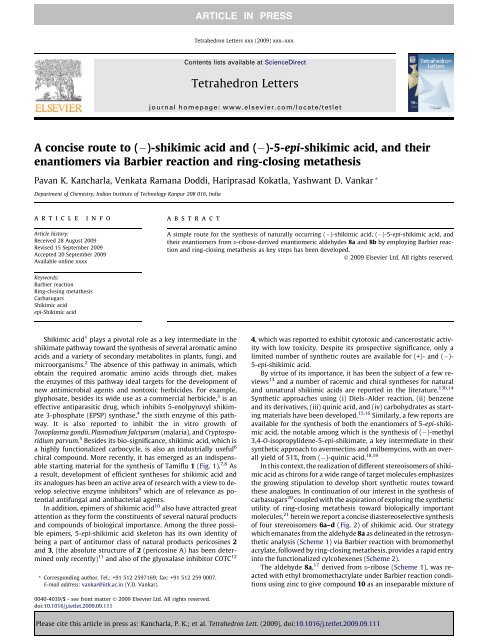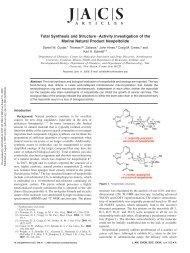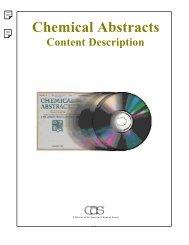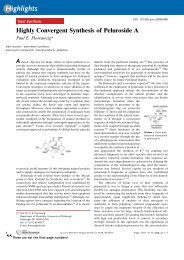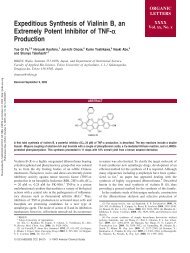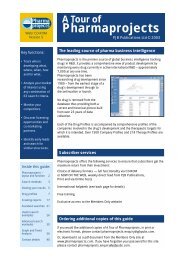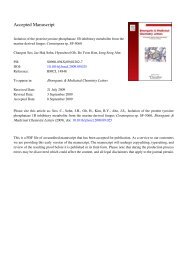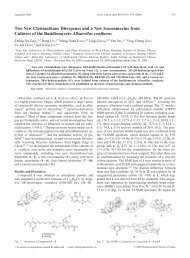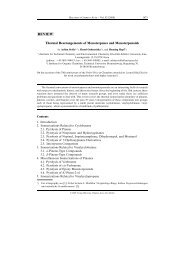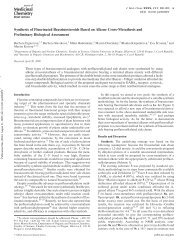A concise route to (−)-shikimic acid and (−)-5-epi-shikimic acid, and ...
A concise route to (−)-shikimic acid and (−)-5-epi-shikimic acid, and ...
A concise route to (−)-shikimic acid and (−)-5-epi-shikimic acid, and ...
Create successful ePaper yourself
Turn your PDF publications into a flip-book with our unique Google optimized e-Paper software.
A <strong>concise</strong> <strong>route</strong> <strong>to</strong> ( )-<strong>shikimic</strong> <strong>acid</strong> <strong>and</strong> ( )-5-<strong>epi</strong>-<strong>shikimic</strong> <strong>acid</strong>, <strong>and</strong> their<br />
enantiomers via Barbier reaction <strong>and</strong> ring-closing metathesis<br />
Pavan K. Kancharla, Venkata Ramana Doddi, Hariprasad Kokatla, Yashwant D. Vankar *<br />
Department of Chemistry, Indian Institute of Technology Kanpur 208 016, India<br />
article info<br />
Article his<strong>to</strong>ry:<br />
Received 28 August 2009<br />
Revised 15 September 2009<br />
Accepted 20 September 2009<br />
Available online xxxx<br />
Keywords:<br />
Barbier reaction<br />
Ring-closing metathesis<br />
Carbasugars<br />
Shikimic <strong>acid</strong><br />
<strong>epi</strong>-Shikimic <strong>acid</strong><br />
abstract<br />
Shikimic <strong>acid</strong> 1 plays a pivotal role as a key intermediate in the<br />
shikimate pathway <strong>to</strong>ward the synthesis of several aromatic amino<br />
<strong>acid</strong>s <strong>and</strong> a variety of secondary metabolites in plants, fungi, <strong>and</strong><br />
microorganisms. 2 The absence of this pathway in animals, which<br />
obtain the required aromatic amino <strong>acid</strong>s through diet, makes<br />
the enzymes of this pathway ideal targets for the development of<br />
new antimicrobial agents <strong>and</strong> non<strong>to</strong>xic herbicides. For example,<br />
glyphosate, besides its wide use as a commercial herbicide, 3 is an<br />
effective antiparasitic drug, which inhibits 5-enolpyruvyl shikimate<br />
3-phosphate (EPSP) synthase, 4 the sixth enzyme of this pathway.<br />
It is also reported <strong>to</strong> inhibit the in vitro growth of<br />
Toxoplasma gondii, Plasmodium falciparum (malaria), <strong>and</strong> Cryp<strong>to</strong>sporidium<br />
parvum. 5 Besides its bio-significance, <strong>shikimic</strong> <strong>acid</strong>, which is<br />
a highly functionalized carbocycle, is also an industrially useful 6<br />
chiral compound. More recently, it has emerged as an indispensable<br />
starting material for the synthesis of Tamiflu 1 (Fig. 1). 7,8 As<br />
a result, development of efficient syntheses for <strong>shikimic</strong> <strong>acid</strong> <strong>and</strong><br />
its analogues has been an active area of research with a view <strong>to</strong> develop<br />
selective enzyme inhibi<strong>to</strong>rs 9 which are of relevance as potential<br />
antifungal <strong>and</strong> antibacterial agents.<br />
In addition, <strong>epi</strong>mers of <strong>shikimic</strong> <strong>acid</strong> 10 also have attracted great<br />
attention as they form the constituents of several natural products<br />
<strong>and</strong> compounds of biological importance. Among the three possible<br />
<strong>epi</strong>mers, 5-<strong>epi</strong>-<strong>shikimic</strong> <strong>acid</strong> skele<strong>to</strong>n has its own identity of<br />
being a part of antitumor class of natural products pericosines 2<br />
<strong>and</strong> 3, (the absolute structure of 2 (pericosine A) has been determined<br />
only recently) 11 <strong>and</strong> also of the glyoxalase inhibi<strong>to</strong>r COTC 12<br />
* Corresponding author. Tel.: +91 512 2597169; fax: +91 512 259 0007.<br />
E-mail address: vankar@iitk.ac.in (Y.D. Vankar).<br />
0040-4039/$ - see front matter Ó 2009 Elsevier Ltd. All rights reserved.<br />
doi:10.1016/j.tetlet.2009.09.111<br />
ARTICLE IN PRESS<br />
Tetrahedron Letters xxx (2009) xxx–xxx<br />
Contents lists available at ScienceDirect<br />
Tetrahedron Letters<br />
journal homepage: www.elsevier.com/locate/tetlet<br />
A simple <strong>route</strong> for the synthesis of naturally occurring ( )-<strong>shikimic</strong> <strong>acid</strong>, ( )-5-<strong>epi</strong>-<strong>shikimic</strong> <strong>acid</strong>, <strong>and</strong><br />
their enantiomers from D-ribose-derived enantiomeric aldehydes 8a <strong>and</strong> 8b by employing Barbier reaction<br />
<strong>and</strong> ring-closing metathesis as key steps has been developed.<br />
Ó 2009 Elsevier Ltd. All rights reserved.<br />
4, which was reported <strong>to</strong> exhibit cy<strong>to</strong><strong>to</strong>xic <strong>and</strong> cancerostatic activity<br />
with low <strong>to</strong>xicity. Despite its prospective significance, only a<br />
limited number of synthetic <strong>route</strong>s are available for (+)- <strong>and</strong> ( )-<br />
5-<strong>epi</strong>-<strong>shikimic</strong> <strong>acid</strong>.<br />
By virtue of its importance, it has been the subject of a few reviews<br />
13 <strong>and</strong> a number of racemic <strong>and</strong> chiral syntheses for natural<br />
<strong>and</strong> unnatural <strong>shikimic</strong> <strong>acid</strong>s are reported in the literature. 13b,14<br />
Synthetic approaches using (i) Diels–Alder reaction, (ii) benzene<br />
<strong>and</strong> its derivatives, (iii) quinic <strong>acid</strong>, <strong>and</strong> (iv) carbohydrates as starting<br />
materials have been developed. 15,16 Similarly, a few reports are<br />
available for the synthesis of both the enantiomers of 5-<strong>epi</strong>-<strong>shikimic</strong><br />
<strong>acid</strong>, the notable among which is the synthesis of ( )-methyl<br />
3,4-O-isopropylidene-5-<strong>epi</strong>-shikimate, a key intermediate in their<br />
synthetic approach <strong>to</strong> avermectins <strong>and</strong> milbemycins, with an overall<br />
yield of 51%, from ( )-quinic <strong>acid</strong>. 18,19<br />
In this context, the realization of different stereoisomers of <strong>shikimic</strong><br />
<strong>acid</strong> as chirons for a wide range of target molecules emphasizes<br />
the growing stipulation <strong>to</strong> develop short synthetic <strong>route</strong>s <strong>to</strong>ward<br />
these analogues. In continuation of our interest in the synthesis of<br />
carbasugars 20 coupled with the aspiration of exploring the synthetic<br />
utility of ring-closing metathesis <strong>to</strong>ward biologically important<br />
molecules, 21 herein we report a <strong>concise</strong> diastereoselective synthesis<br />
of four stereoisomers 6a–d (Fig. 2) of <strong>shikimic</strong> <strong>acid</strong>. Our strategy<br />
which emanates from the aldehyde 8a as delineated in the retrosynthetic<br />
analysis (Scheme 1) via Barbier reaction with bromomethyl<br />
acrylate, followed by ring-closing metathesis, provides a rapid entry<br />
in<strong>to</strong> the functionalized cylcohexenes (Scheme 2).<br />
The aldehyde 8a, 17 derived from D-ribose (Scheme 1), was reacted<br />
with ethyl bromomethacrylate under Barbier reaction conditions<br />
using zinc <strong>to</strong> give compound 10 as an inseparable mixture of<br />
Please cite this article in press as: Kancharla, P. K.; et al. Tetrahedron Lett. (2009), doi:10.1016/j.tetlet.2009.09.111
HO<br />
HO<br />
OH<br />
CO 2H<br />
(-)-5-<strong>epi</strong>-<strong>shikimic</strong> <strong>acid</strong><br />
6a<br />
two diastereomers in 2:1 ratio. The presence of five olefinic pro<strong>to</strong>ns<br />
for both the diastereomers in the 1 H NMR spectrum (d 6.28–<br />
5.27), in addition <strong>to</strong> other data, confirms the formation of the product.<br />
The free hydroxyl group was converted <strong>to</strong> p-nitrobenzoate ester<br />
by treating with p-nitrobenzoyl chloride <strong>and</strong> pyridine where<br />
the two diastereomers were successfully separated through column<br />
chroma<strong>to</strong>graphy. Various attempts <strong>to</strong> cyclize the major diastereomer<br />
11 using 1st <strong>and</strong> 2nd generation Grubbs’ catalysts<br />
resulted in failure. We, therefore, attempted <strong>to</strong> cyclize the unprotected<br />
diene 10 using 1st generation Grubbs’ catalyst, which also<br />
met with failure even in refluxing <strong>to</strong>luene. However, ring-closing<br />
metathesis of 10 22 proceeded smoothly in the presence of<br />
4 mol % of Grubbs’ 2nd generation catalyst <strong>to</strong> yield the <strong>shikimic</strong><br />
<strong>acid</strong> skele<strong>to</strong>n 13 in 80% yield albeit again as an inseparable diastereomeric<br />
mixture. The disappearance of the multiplet due <strong>to</strong> five<br />
olefinic pro<strong>to</strong>ns in the region d 6.28–5.27 <strong>and</strong> the appearance of<br />
O<br />
AcHN<br />
HO<br />
HO<br />
OH<br />
CO 2H<br />
(-)-<strong>shikimic</strong> <strong>acid</strong><br />
6b<br />
HO<br />
OH<br />
HO CO2H (+)-<strong>shikimic</strong><strong>acid</strong> 6c<br />
Figure 2. Structures of four stereosiomers of <strong>shikimic</strong> <strong>acid</strong> synthesized.<br />
OH<br />
HO<br />
PO<br />
HO<br />
6<br />
CO2H PO<br />
7<br />
OP1 1<br />
HO<br />
HO<br />
CO 2Et<br />
NH 2 . H3PO 4<br />
O<br />
O<br />
OH<br />
D-ribose<br />
ARTICLE IN PRESS<br />
2 P. K. Kancharla et al. / Tetrahedron Letters xxx (2009) xxx–xxx<br />
O<br />
OH<br />
OH<br />
O<br />
HO<br />
HO<br />
CO 2Et<br />
Cl<br />
OH<br />
2<br />
HO<br />
CO 2Me<br />
HO<br />
O O<br />
8a<br />
85 %<br />
over two steps<br />
(ref 17)<br />
O<br />
O O<br />
69 %<br />
OH<br />
O<br />
OMe<br />
Scheme 1. Retrosynthesis of Shikimic <strong>acid</strong>.<br />
HO<br />
HO<br />
HO<br />
OH<br />
OH<br />
OH<br />
OH<br />
(-)-MK7607<br />
4 5<br />
HO<br />
OMe<br />
CO2Me OH<br />
3<br />
Figure 1. Structures of some biologically important functionalized cyclohexenes.<br />
HO<br />
OH<br />
HO CO2H (+)-5-<strong>epi</strong>-<strong>shikimic</strong> <strong>acid</strong><br />
6d<br />
O O<br />
8b<br />
O<br />
O O<br />
93 %<br />
O<br />
65 %<br />
over two steps<br />
(ref 17)<br />
OH<br />
two new sets of signals at d 6.93 <strong>and</strong> d 6.80 in its 1 H NMR spectrum,<br />
one for each diastereomer, confirmed that the cyclization had occurred.<br />
The appearance of each of the olefinic pro<strong>to</strong>ns of the endocyclic<br />
double bond of each isomer as a multiplet indicates strong<br />
allylic coupling with C-6 pro<strong>to</strong>ns. The diastereomeric mixture<br />
was then subjected <strong>to</strong> esterification with p-nitrobenzoyl chloride<br />
<strong>and</strong> triethylamine <strong>to</strong> obtain the p-nitrobenzoate ester in quantitative<br />
yield. Cleavage of the ace<strong>to</strong>nide group using 60% acetic <strong>acid</strong><br />
followed by acetylation provided chroma<strong>to</strong>graphically separable<br />
mixture of diastereomers 15 <strong>and</strong> 16.<br />
The chemical shifts of various pro<strong>to</strong>ns in the 1 H NMR spectra of<br />
15 <strong>and</strong> 16 were assigned using the COSY spectral data. The stereochemistry<br />
of the newly generated stereocenter in both the separated<br />
shikimate derivatives was deduced using the NOE spectral<br />
analysis (Fig. 3). Thus, in an NOE experiment, irradiation of the signal<br />
for H-5 in the major isomer 15 led <strong>to</strong> the enhancement of H-4<br />
Please cite this article in press as: Kancharla, P. K.; et al. Tetrahedron Lett. (2009), doi:10.1016/j.tetlet.2009.09.111
11.0%<br />
Br<br />
CO2Et 9<br />
8a<br />
Zn, cat. NH4Cl THF, 81%<br />
O<br />
O<br />
OH<br />
10<br />
CO2Et PNBCl<br />
Pyridine<br />
O CO2Et O<br />
11 OPNB<br />
major seperated<br />
isomer<br />
O<br />
PNBO<br />
O<br />
12<br />
10<br />
O<br />
4mol% 2nd generation<br />
5<br />
Grubbs' catalyst HO<br />
OAc<br />
O<br />
3<br />
2<br />
4<br />
PNBCl, Et3N 6<br />
1 CO2Et DCM, 98%<br />
13<br />
O<br />
PNBO<br />
OH<br />
O<br />
14<br />
CO2Et 1. 60% AcOH<br />
2. Ac2O, Et3N 91% over two steps<br />
AcO<br />
HO<br />
1N NaOH<br />
R1 R2 CO2Et R1 R2 CO2H PNBCl: p-nitrobenzoyl<br />
chloride<br />
15 R1 =OPNB,R2 =H<br />
6a R1 =OH,R2 =H61%<br />
16 R1 =H,R2 =OPNB<br />
6b R1 =H,R2 =OH65%<br />
AcO<br />
H<br />
AcO<br />
4<br />
PNBO<br />
H 5<br />
H 3<br />
CO 2Et<br />
8.4%<br />
(11%) <strong>and</strong> H-3 signals (8.4%) indicating that H-5 is cis <strong>to</strong> H-3 <strong>and</strong><br />
correspondingly revealing the cis relation between the OPNB group<br />
<strong>and</strong> both the ace<strong>to</strong>xy groups <strong>and</strong> thus concluding the major isomer<br />
<strong>to</strong> be the 5-<strong>epi</strong>-shikimate derivative. However, irradiation of the<br />
signal for H-5 in the minor isomer 16 also led <strong>to</strong> a small enhancement<br />
23 (3%) of the signal for H-4 <strong>and</strong> no enhancement in the signal<br />
for H-3. It is clear that the conformations of molecules 15 <strong>and</strong> 16<br />
are either half chair or slightly dis<strong>to</strong>rted 23b which allows H-5 <strong>and</strong><br />
H-4 <strong>to</strong> come closer <strong>and</strong> exhibit small NOE in compound 16. How-<br />
Scheme 2. Synthesis of ( )-5-<strong>epi</strong>-<strong>shikimic</strong> <strong>acid</strong> 6a <strong>and</strong> ( )-<strong>shikimic</strong> <strong>acid</strong> 6b.<br />
AcO<br />
H<br />
AcO<br />
4 H3 PNBO CO<br />
H<br />
2Et<br />
5<br />
3.0%<br />
15 16<br />
Figure 3. Diagnostic NOE correlations for the compounds 15 <strong>and</strong> 16.<br />
9<br />
PNBCl, Et 3N<br />
DCM, 98%<br />
8b<br />
O<br />
PNBO<br />
Zn, cat. NH 4Cl<br />
THF, 81%<br />
O<br />
19<br />
ARTICLE IN PRESS<br />
P. K. Kancharla et al. / Tetrahedron Letters xxx (2009) xxx–xxx 3<br />
O<br />
O<br />
X<br />
OH<br />
17<br />
1. 60% AcOH<br />
2. Ac2O, Et3N CO2Et 91% over<br />
two steps<br />
CO 2Et<br />
AcO<br />
CO 2Et<br />
ever, the absolute configurations at C-5 in both 15 <strong>and</strong> 16 are as<br />
shown in Figure 3 which was further confirmed by converting<br />
them in<strong>to</strong> known ( )-5-<strong>epi</strong>-<strong>shikimic</strong> <strong>acid</strong> 6a <strong>and</strong> ( )-<strong>shikimic</strong> <strong>acid</strong><br />
6b (vide infra), respectively. The global deprotection of both the<br />
shikimate derivatives was carried out in one pot, by treating with<br />
1 N NaOH solution <strong>and</strong> the products were obtained in their pure<br />
forms 24–26 after passing through a short plug of silica gel. Thus,<br />
( )-5-<strong>epi</strong>-<strong>shikimic</strong> <strong>acid</strong> was obtained in 19% overall yield whereas<br />
the naturally occurring ( )-<strong>shikimic</strong> <strong>acid</strong> was obtained with an<br />
overall yield of 9% starting from the aldehyde 8a.<br />
Similarly, (+)-5-<strong>epi</strong>-<strong>shikimic</strong> <strong>acid</strong> 6c <strong>and</strong> (+)-<strong>shikimic</strong> <strong>acid</strong> 6d<br />
were also synthesized (Scheme 3) following the same synthetic sequence<br />
starting from the D-ribose-derived aldehyde 8b. All the<br />
spectral data 24,26 of the intermediates as well as the final compounds,<br />
except the rotation being opposite, were in absolute match<br />
with their enantiomers.<br />
In summary, we have developed a <strong>concise</strong> <strong>route</strong> for the synthesis<br />
of ( )-5-<strong>epi</strong>-<strong>shikimic</strong> <strong>acid</strong>, (+)-5-<strong>epi</strong>-<strong>shikimic</strong> <strong>acid</strong>, <strong>and</strong> (+)-<strong>shikimic</strong><br />
<strong>acid</strong> along with the naturally occurring ( )-<strong>shikimic</strong> <strong>acid</strong><br />
via Barbier reaction followed by ring-closing metathesis as key<br />
steps. This approach <strong>to</strong>ward the synthesis of functionalized cyclo-<br />
R1 R2 4mol% 2nd generation<br />
Grubbs' catalyst<br />
75%<br />
OAc<br />
CO 2Et<br />
20 R1 =H,R2 =OPNB<br />
21 R1 = OPNB, R2 =H<br />
1N NaOH<br />
Scheme 3. Synthesis of (+)-5-<strong>epi</strong>-<strong>shikimic</strong> <strong>acid</strong> 6c <strong>and</strong> (+)-<strong>shikimic</strong> <strong>acid</strong> 6d.<br />
O<br />
HO<br />
HO<br />
18<br />
R1 R2 O<br />
OH<br />
CO 2Et<br />
CO 2H<br />
6c R1 =H,R2 =OH 61%<br />
6d R1 =OH,R2 =H65%<br />
Please cite this article in press as: Kancharla, P. K.; et al. Tetrahedron Lett. (2009), doi:10.1016/j.tetlet.2009.09.111
hexenes, especially <strong>to</strong> derive different stereoisomers of <strong>shikimic</strong><br />
<strong>acid</strong>, is exemplary <strong>and</strong> might also be applicable <strong>to</strong> several other<br />
pseudosugars <strong>and</strong> biologically important molecules.<br />
Supplementary data<br />
Supplementary data associated with this article can be found, in<br />
the online version, at doi:10.1016/j.tetlet.2009.09.111.<br />
References <strong>and</strong> notes<br />
1. Eykman, J. F. Recl. Tray. Chim. Pays-Bas 1885, 4, 32.<br />
2. Kishore, G. M.; Shah, D. M. Annu. Rev. Biochem. 1988, 57, 627.<br />
3. U.S. Environmental Protection Agency. Technical Factsheet on: GLYPHOSATE,<br />
2006.<br />
4. Sikorski, J. Acc. Chem. Res. 1997, 30, 2.<br />
5. Roberts, F.; Roberts, C. W.; Johnson, J. J.; Kyle, D. E.; Krell, T.; Coggins, J. R.;<br />
Coombs, G. H.; Milhous, W. K.; Tzipori, S.; Ferguson, D. J. P.; Chakrabarti, D.;<br />
McLeod, R. Nature 1998, 393, 801.<br />
6. Johansson, L.; Liden, G. J. Biotechnol. 2006, 126, 528.<br />
7. (a) Kim, C. U.; Liu, W.; Williams, M. A.; Liu, H.; Zhang, L.; Swaminathan, S.;<br />
Bischofberger, N.; Chen, M. S.; Mendel, D. B.; Tai, C. Y.; Laver, G.; Stevens, R. C. J.<br />
Am. Chem. Soc. 1997, 119, 681; (b) Rohloff, J. C.; Kent, K. M.; Postich, M. J.;<br />
Becker, M. W.; Chapman, H. H.; Kelly, D. E.; Lew, W.; Louie, M. S.; McGee, L. R.;<br />
Prisbe, E. J.; Schultze, L. M.; Yu, R. H.; Zhang, L. J. Org. Chem. 1998, 63, 4545; (c)<br />
Nie, L.-D.; Shi, X.-X.; Ko, K. H.; Lu, W.-D. J. Org. Chem. 2009, 74, 3970.<br />
8. Trifonov, V.; Khiabanian, H.; Greenbaum, B.; Rabadan, R. Eurosurveillance 2009,<br />
4, 17.<br />
9. (a) Jiang, S.; Singh, G.; Boam, D. J.; Coggins, J. R. Tetrahedron: Asymmetry 1999,<br />
10, 4087; (b) Brettle, R.; Cross, R.; Frederickson, M.; Haslam, E.; MacBeath, F. S.;<br />
Davies, G. M. Tetrahedron 1996, 52, 10547; (c) Adams, H.; Bailey, N. A.; Brettle,<br />
R.; Cross, R.; Frederickson, M.; Haslam, E.; MacBeath, F. S.; Davies, G. M.<br />
Tetrahedron 1996, 52, 8565.<br />
10. (a) Armes<strong>to</strong>, N.; Ferrero, M.; Fernández, S.; Go<strong>to</strong>r, V. Tetrahedron Lett. 2000, 41,<br />
8759. <strong>and</strong> references cited therein; (b) Posner, G. H.; Wettlaufer, D. G. J. Am.<br />
Chem. Soc. 1986, 108, 7373; (c) Pornpakakul, S.; Pritchard, R. G.; S<strong>to</strong>odley, R. J.<br />
Tetrahedron Lett. 2000, 41, 2691; (d) Snyder, C. D.; Rapoport, H. J. Am. Chem. Soc.<br />
1973, 95, 7821.<br />
11. Usami, Y.; Takaoka, I.; Ichikawa, H.; Horibe, Y.; Tomiyama, S.; Ohtsuka, M.;<br />
Imanishi, Y.; Arimo<strong>to</strong>, M. J. Org. Chem. 2007, 72, 6127.<br />
12. Kamiya, D.; Uchiata, Y.; Ichikawa, E.; Ka<strong>to</strong>, K.; Umezawa, K. Bioorg. Med. Chem.<br />
Lett. 2005, 15, 1111.<br />
13. (a) Bohm, B. A. Chem. Rev. 1965, 65, 435; (b) Jiang, S.; Singh, G. Tetrahedron<br />
1998, 54, 4697.<br />
14. Bestmann, H. J.; Held, H. A. Angew. Chem., Int. Ed. Engl. 1971, 10, 336.<br />
15. (a) Jiang, S.; Mekki, B.; Sing, G.; Wightman, R. H. Tetrahedron Lett. 1994, 35,<br />
5505; (b) Jiang, S.; Mekki, B.; Singh, G.; Wightman, R. H. J. Chem. Soc., Perkin<br />
Trans. 1 1997, 1805.<br />
16. Mirza, S.; Vasella, A. Helv. Chim. Acta 1984, 67, 1562.<br />
17. Smith, A. B., III; Han, Q.; Breslin, P. A. S.; Beauchamp, G. K. Org. Lett. 2005, 7,<br />
5075.<br />
18. Hanessian, S.; Beaulieu, P.; Dube, D. Tetrahedron Lett. 1986, 27, 5071.<br />
19. Lesuisse, D.; Berch<strong>to</strong>ld, G. A. J. Org. Chem. 1985, 50, 888.<br />
20. (a) Doddi, V. R.; Kumar, A.; Vankar, Y. D. Tetrahedron 2008, 64, 9117; (b) Doddi,<br />
V. R.; Kancharla, P. K.; Reddy, Y. S.; Kumar, A.; Vankar, Y. D. Carbohydr. Res.<br />
2009, 344, 606.<br />
21. (a) Kumar, A.; Rawal, G. K.; Vankar, Y. D. Tetrahedron 2008, 64, 2379; (b)<br />
Ramana, D. V.; Vankar, Y. D. Eur. J. Org. Chem. 2007, 5583; (c) Reddy, B. G.;<br />
Vankar, Y. D. Angew. Chem., Int. Ed. 2005, 44, 2001.<br />
22. For ring-closing metathesis using vinyl acrylates, see: (a) Julie, T.; Joelle, P.<br />
Synlett 2006, 17, 2807; (b) Fustero, S.; Sanchez-Rosello, M.; Rodrigo, V.; Pozo, C.<br />
D.; Sanz-Cervera, J. F.; Simon, A. Org. Lett. 2006, 18, 4129; (c) Krafft, M. E.; Song,<br />
E.-H.; Davoile, R. J. Tetrahedron Lett. 2005, 46, 6359; (d) Thorstensson, F.;<br />
Kvarnstrom, I.; Musil, D.; Nilsson, I.; Samuelsson, B. J. Med. Chem. 2003, 46,<br />
1165.<br />
23. For similar observations see: (a) Liu, S.-L.; Shi, X.-X.; Xu, Y.-L.; Xu, W.; Dong, J.<br />
Tetrahedron: Asymmetry 2009, 20, 78; (b) Bell, R. A.; Osakwe, E. N. C. Chem.<br />
Commun. 1968, 1093.<br />
24. Adrio, J.; Carretero, J. C.; Ruano, J. L. G.; Cabrejas, L. M. J. Tetrahedron: Asymmetry<br />
1997, 8, 1623.<br />
25. Experimental data of selected compounds.Ethyl 4-((4S,5R)-2,2-dimethyl-5vinyl-1,3-dioxolan-4-yl)-4-hydroxy-2-ethylenebutanoate<br />
(10): To a cold (10 °C)<br />
<strong>and</strong> well stirred mixture of 8a (500 g, 3.20 mmol), Zn dust (403 mg, 6.39 mmol)<br />
<strong>and</strong> bromoester 9 (611 mg, 3.19 mmol) in 10 mL of THF was added a saturated<br />
solution of NH4Cl (1 mL). The mixture was stirred for 4 h at ambient<br />
temperature until the aldehyde was <strong>to</strong>tally consumed (moni<strong>to</strong>red by TLC).<br />
ARTICLE IN PRESS<br />
4 P. K. Kancharla et al. / Tetrahedron Letters xxx (2009) xxx–xxx<br />
The mixture was filtered <strong>and</strong> the precipitate was thoroughly washed with<br />
CHCl3 (4 3 mL). The aqueous layer was separated <strong>and</strong> treated with 5% HCl <strong>to</strong><br />
dissolve the suspended turbid material. The clear solution was extracted with<br />
CHCl3 (3 25 mL). The combined organic layer was washed successively with<br />
10% NaHCO3, water, <strong>and</strong> finally with brine solution. After removal of the<br />
solvent under reduced pressure a residue was obtained, which was purified by<br />
column chroma<strong>to</strong>graphy <strong>to</strong> give compound 10 (709 mg, 81%) as a mixture of<br />
two diastereomers (1:2). Yellow oil, Rf = 0.65 (4:1 hexanes:EtOAc); IR (thin<br />
film) 3470, 3084, 2985, 2934, 1714, 1629, 1431, 1214, 1057 cm 1 ; 1 H NMR<br />
(500 MHz, CDCl3) d 6.28 (d, J = 1.1 Hz, 1H, major), 6.27 (d, J = 1.1 Hz, 1H, minor),<br />
6.07–6.0 (m, 1H, both isomers), 5.73 (s, 1H, major), 5.69 (d, J = 1.1 Hz, 1H,<br />
minor), 5.43 (dd, J = 5.1 Hz, J = 17.1 Hz, 1H, major), 5.30–5.39 (m, 2H, both<br />
isomers), 5.27 (d, J = 10.9 Hz, 1H, major), 4.68 (t, J = 6.8 Hz, 1H, major), 4.61 (t,<br />
J = 7.4 Hz, 1H, minor), 4.19–4.25 (m, 2H, major), 4.05 (dd, J = 4.6 Hz, J = 6.8 Hz,<br />
1H, minor), 4.05 (dd, J = 6.3 Hz, J = 8.6 Hz, 1H, major), 3.79–3.75 (m, 1H, both<br />
isomers), 2.92 (d, J = 4.0 Hz, 1H), 2.84 (dd, J = 2.3 Hz, J = 14.3 Hz, 1H), 2.55–2.44<br />
(m, 2H, both isomers), 1.53 (s, 3H, minor), 1.50 (s, 3H, major), 1.39 (s, 3H,<br />
minor), 1.37 (s, 3H, major), 1.33–1.29 (3H, both isomers); 13 C NMR (125 MHz,<br />
CDCl3) d (major): 168.6, 137.1, 134.3, 128.4, 117.9, 108.7, 80.2, 78.8, 68.4, 61.3,<br />
36.8, 27.8, 25.5, 14.2. (minor): 167.3, 136.9, 134.3, 127.8, 119.7, 79.2, 68.4, 60.9,<br />
37.1, 27.3, 25.0, 14.2. Calculated for C19H25NO6Na [M+Na]+: 293.1365, found<br />
293.1361.<br />
(3aR,7aS)-Ethyl 7-hydroxy-2,2-dimethyl-3a,6,7,7a-tetrahydrobenzo[d][1,3]dioxole-5-carboxylate<br />
(13): To a stirred solution of compound 10 (300 mg,<br />
0.9 mmol) in dry CH2Cl2 (5 mL) at room temperature was added Grubbs’ 2 nd<br />
generation catalyst (4 mol %, 30.5 mg). The mixture was refluxed for 5 h <strong>and</strong><br />
after completion of the reaction, the solvent was evaporated under reduced<br />
pressure <strong>and</strong> the crude product was purified by column chroma<strong>to</strong>graphy <strong>to</strong><br />
give compound 13 (193 mg, 72% yield) as a viscous colorless liquid. Rf = 0.22<br />
(4:1 hexanes:EtOAc); IR (thin film) 3426, 2985, 2933, 1714, 1651, 1446, 1373,<br />
1296, 1238, 1095, 1058 cm 1 ; 1 H NMR (500 MHz, CDCl3) d 6.93 (m, 1H, minor),<br />
6.79 (m, 1H, major), 4.72–4.76 (m, 1H, both isomers), 4.41 (dd, J = 2.8 Hz,<br />
J = 5.7 Hz, 1H, major), 4.24–4.20 (m, 2H, both isomers), 4.08 (dd, J = 6.2 Hz,<br />
J = 7.1 Hz 1H, minor), 3.98–3.93 (m, 1H, major), 3.89–3.88 (m, 1H, minor), 2.81<br />
(dd, J = 4.5 Hz, J = 17.1 Hz 1H, minor), 2.70 (dd, J = 5.1 Hz, J = 16.6 Hz 1H,<br />
major), 2.53–2.48 (m, 1H, minor), 4.19–4.25 (m, 2H, major), 4.05 (dd, J = 4.6 Hz,<br />
J = 6.8 Hz, 1H minor), 4.05 (dd, J = 6.3 Hz, J = 8.6 Hz, 1H major), 3.79–3.75 (m,<br />
1H, both isomers), 2.92 (d, J = 4.0 Hz, 1H), 2.84 (dd, J = 2.3 Hz, J = 14.3 Hz, 1H),<br />
2.53–2.48 (m, 1H, major), 2.17–2.20 (m, 1H, minor), 1.46 (s, 3H minor), 1.42 (s,<br />
3H, major), 1.41 (s, 3H, major), 1.40 (3H, minor), 1.32–1.30 (m, 3H, both<br />
isomers); 13 C NMR (125 MHz, CDCl3) d (major): 166.3, 134.5, 129.5, 110.0,<br />
75.4, 72.9, 66.9, 61.1, 27.8, 27.4, 26.0, 14.2. (minor): 166.1, 133.5, 131.2, 109.8,<br />
78.2, 72.3, 69.1, 61.1, 29.5, 28.1, 25.8, 14.2. Calculated for C19H25NO6Na<br />
[M+Na] + : 265.1052, found 265.1056.<br />
Procedure for the deprotection of ace<strong>to</strong>nide 14.<br />
Compound 14 (250 mg, 0.63 mmol) was dissolved in 1.5 mL of 60% acetic <strong>acid</strong><br />
<strong>and</strong> refluxed for 10 h at 60 °C. The reaction mixture was concentrated under<br />
reduced pressure, diluted with water, <strong>and</strong> extracted with ethyl acetate<br />
(4 25 mL). The organic layer was dried over Na2SO4 <strong>and</strong> the filtrate was<br />
concentrated under vacuum <strong>to</strong> obtain the corresponding diol, which was<br />
subjected <strong>to</strong> acetylation with excess of triethylamine, Ac2O (1:1, 1 mL) <strong>and</strong> a<br />
catalytic amount of DMAP at room temperature for 6 h. Removal of solvent<br />
under reduced pressure gave a residue which was purified by column<br />
chroma<strong>to</strong>graphy (hexane/EtOAc 9:1) <strong>to</strong> obtain the mixture of diastereomers<br />
as light yellow oil. (15/16; 68:32 ratio) (253 mg, 91%).<br />
(1S,2R,6S)-4-(Ethoxycarbonyl)-6-(4-nitrobenzoyloxy)-cyclohex-3-ene-1,2-diyl<br />
diacetate (15): Yellow oil, a24 D ¼ 100:0 (c 1.10, CH2Cl2). Rf = 0.37 (9:1<br />
hexanes:EtOAc); IR (thin film) 3112, 3055, 2924, 2853, 1749, 1729, 1659,<br />
1234, 1146, 1079 cm 1 ; 1 H NMR (500 MHz, CDCl3) d 8.29 (d, J = 8.4 Hz, 2H, Ph),<br />
8.16 (d, J = 8.4 Hz, 2H, Ph), 6.83–6.82 (m, 1H, H2), 5.80 (t, J = 4.2 Hz, 1H, H3),<br />
5.57–5.53 (m, 1H, H5), 5.43 (dd, J = 3.8 Hz, J = 8.0 Hz 1H, H4), 4.22 (q, J = 7.2 Hz,<br />
2H, H2’), 3.13 (dd, J = 5.7 Hz, J = 8.3 Hz, 1H, H6), 2.54 (dd, J = 6.4 Hz, J = 8.7 Hz,<br />
1H, H6), 2.10 (s, 3H, OAc), 2.01 (s, 3H, OAc), 1.30 (t, J = 7.2 Hz, 3H, H3’); 13 C<br />
NMR (125 MHz, CDCl3) d 169.9, 165.2, 163.6, 150.7, 134.7, 132.0, 131.7, 120.8,<br />
123.6, 68.5, 68.1, 65.8, 61.4, 29.0, 20.7, 20.6, 14.1. Calculated for C19H25NO6Na<br />
[M+Na] + : 458.1063, found 458.1061.<br />
(1S,2R,6R)-4-(Ethoxycarbonyl)-6-(4-nitrobenzoyloxy)- cyclohex-3-ene-1,2-diyl<br />
diacetate (16): Yellow oil, a24 D ¼ 26:6 (c0.45, CH2Cl2). Rf = 0.36 (9:1<br />
hexanes:EtOAc); IR (thin film) 3112, 2924, 2853, 1749, 1727, 1657, 1233,<br />
1120, 1044 cm 1 ; 1 H NMR (500 MHz, CDCl3) d 8.30–8.27 (m, 2H, Ph), 8.17–<br />
8.14 (m, 2H, Ph), 6.70 (br s, 1H, H2), 5.77 (br s, 1H, H3), 5.66 (br s, 1H, H4),<br />
5.44–5.41 (m, 1H, H5), 4.25 (q, J = 7.2 Hz, 2H, H2’), 2.96(dd, J = 5.8 Hz,<br />
J = 17.8 Hz, 1H, H6), 2.75–2.73 (m, 1H, H6), 2.12(s, 3H, OAc), 2.04 (s, 3H,<br />
OAc), 1.33 (t, J = 7.2 Hz, 3H, H3’); 13 C NMR (125 MHz, CDCl3) d 170.2, 169.7,<br />
165.1, 163.6, 150.7, 134.8, 133.5, 130.8, 130.5, 123.5, 69.2, 67.5, 67.2, 61.3,<br />
26.8, 20.7, 20.6, 14.1. Calculated for C19H25NO6Na [M+Na] + : 458.1063, found<br />
458.1068.<br />
26. Spectral data for these compounds were similar <strong>to</strong> the ones reported for them<br />
in the literature. See Ref. [24] <strong>and</strong> Supplementary data for details.<br />
Please cite this article in press as: Kancharla, P. K.; et al. Tetrahedron Lett. (2009), doi:10.1016/j.tetlet.2009.09.111


